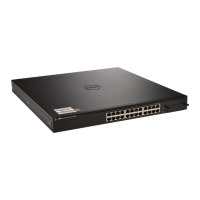Managing a Switch Stack 151
3
A protocol may simply restart after the failover if neighbors react slowly
enough that they will not normally detect the outage.
The NSF feature enables the stack master unit to synchronize the running-
config within 60 seconds after a configuration change has been made.
However, if a lot of configuration changes happen concurrently, NSF uses a
back-off mechanism to reduce the load on the switch. The show nsf
command output includes information about when the next running-config
synchronization will occur.
Initiating a Failover
The NSF feature allows you to initiate a failover using the initiate failover
command, which causes the former stack master to reboot (cold start), and
the new master to perform a warm restart.
Initiating a failover reloads the stack master, triggering the backup unit to
take over. Before the failover, the stack master pushes application data and
other important information to the backup unit. Although the handoff is
controlled and causes minimal network disruption, some application state is
lost, such as pending timers and other pending internal events.
Checkpointing
Switch applications (features) that build up a list of data such as neighbors or
clients can significantly improve their restart behavior by remembering this
data across a warm restart. This data can either be stored persistently, as
DHCP server and DHCP snooping store their bindings database, or the stack
master can checkpoint this data directly to the standby unit. Persistent
storage allows an application on a standalone unit to retain its data across a
restart, but since the amount of storage is limited, persistent storage is not
always practical.
The NSF checkpoint service allows the stack master to communicate certain
data to the backup unit in the stack. When the stack selects a backup unit,
the checkpoint service notifies applications to start a complete checkpoint.
After the initial checkpoint is done, applications checkpoint changes to their
data.

